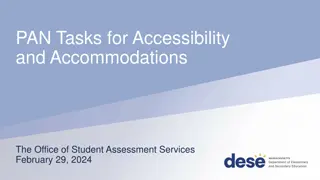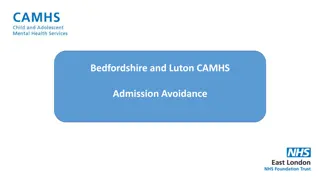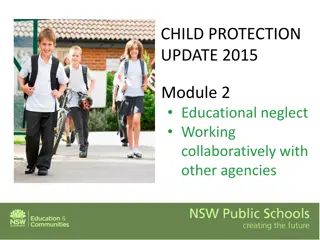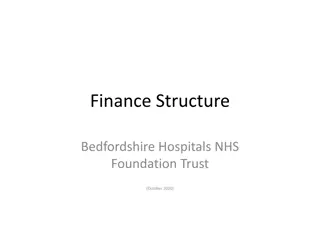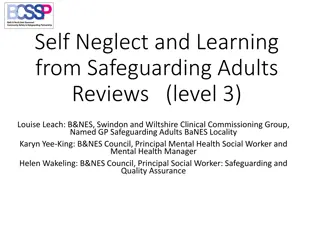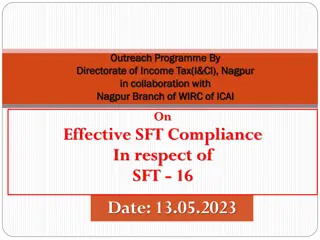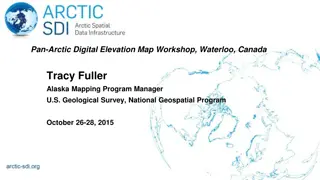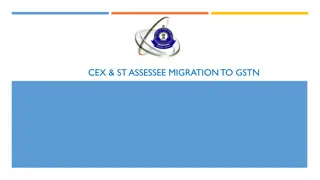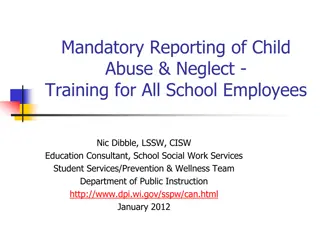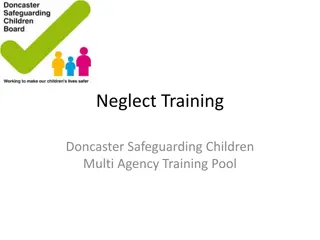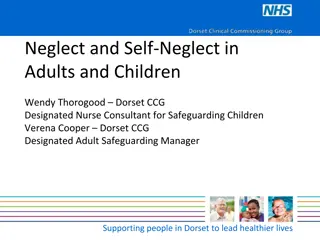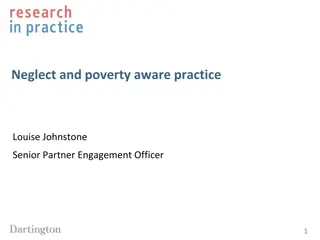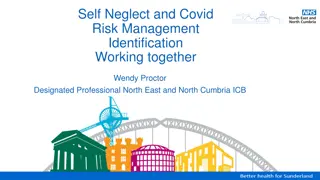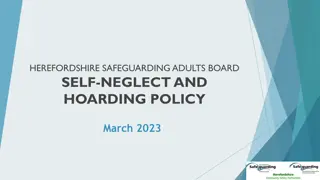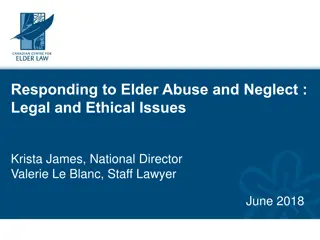PAN Bedfordshire Neglect Strategy Overview
Collaboration in developing a neglect strategy due to concerns about referrals and identification methods. Findings highlight gaps in information sharing, decision-making, and intervention coordination. Strategy aims to improve neglect identification, understand its impact, challenge child poverty, and provide guidance in working with affected families. Underpinning principles focus on child voice, shared understanding of neglect consequences, effective assessments, sustainable outcomes, and workforce training.
Download Presentation

Please find below an Image/Link to download the presentation.
The content on the website is provided AS IS for your information and personal use only. It may not be sold, licensed, or shared on other websites without obtaining consent from the author.If you encounter any issues during the download, it is possible that the publisher has removed the file from their server.
You are allowed to download the files provided on this website for personal or commercial use, subject to the condition that they are used lawfully. All files are the property of their respective owners.
The content on the website is provided AS IS for your information and personal use only. It may not be sold, licensed, or shared on other websites without obtaining consent from the author.
E N D
Presentation Transcript
PAN BEDFORDSHIRE NEGLECT STRATEGY 2022-2026 PRESENTED BY TERESA GALLAGHER
CONTEXT IN 2016, THE THREE BEDFORDSHIRE LSCBS, AGREED TO COLLABORATE AND DEVELOP A PAN BEDS NEGLECT STRATEGY BECAUSE: a. THERE WERE CONCERNS ABOUT THE LEVELS OF REFERRALS FOR NEGLECT b. CONCERNS ABOUT THE WAY NEGLECT WAS BEING IDENTIFIED AND ASSESSED.
FINDINGS FROM CSPRS/AUDITS/RAPID REVIEWS Gaps in information sharing and communication between agencies and a lack of clarity about how work should be coordinated by targeted or universal services. Agencies were reticent in taking to responsibility to act as the lead professional or coordinate the intervention. The lack of curiosity and potentially a reluctance to ask or challenge things in case this may be viewed as offensive or not even considered. In all of the cases, interventions and decisions were made without knowing the context of previous events. Some of the findings showed practitioners did not consider the use the GCP2 assessment. The multi-professional meetings did not rigorously explore the fact that almost all the engagement was being directed by the parents. It was noted that some professionals recognised they had overestimated their relationship with the mothers, and assumed rather than knew that mothers would do the right thing for the child. The findings show there wasn t an explicit focus in policy and training on the distinction between neglect caused by poverty and other forms of neglect.
THE AIM OF THE NEGLECT STRATEGY 2023-2026 The aim of this strategy is to enable professionals and practitioners to better identify neglect. Having a shared understanding and definition of neglect across all services and partners is key to developing and embedding a collective approach through practice and training It aims to support practitioners to better understand the impact of neglect on children and their families and provide guidance on different ways we can work with families who are experiencing neglect. The strategy is committed to challenging child poverty and reducing the barriers children and families who live in poverty face. One of the most significant issues currently facing children and their families in Pan Bedfordshire and nationally is the impact of COVID and the cost of living crisis.
THE UNDERPINNING PRINCIPLES AND VALUES OF THE PAN BEDS NEGLECT STRATEGY To consider the lived experience and the voice of the child and how all agencies work together to improve this. A shared understanding of the consequences of neglect and its impact on a children s health, safety and development including the impact of emotional neglect To ensure that good multi-agency assessments lead to clear and decisive planning to prevent drift and delay and ensure children are provided with the right help at the right time by measuring its impact on outcomes To ensure that interventions improve and sustain the outcomes for children in the long term To ensure that the workforce is provided with and know how to use the Graded Care Profile 2 (GCP2) and training to work effectively
SUMMARY OF DEVELOPMENTS IN LUTON: IN 2016 A NEGLECT PRACTICE GUIDANCE WAS LAUNCHED TO IDENTIFY NEGLECT IN LUTON. A NEGLECT CONFERENCE IN 2017. IN 2017/2018, LUTON IMPLEMENTED THE NSPCC GRADED CARE PROFILE 2 (GCP2). THE DELIVERY OF TRAINING ON GPC2 IN CENTRAL BEDS AND LUTON. IN 2017/2018 PAN BEDS INITIATED THE GCP2 AUDIT PRACTICE. AN INDEPENDENT EVALUATION WAS COMMISSIONED TO REVIEW THE IMPLEMENTATION OF GCP2 FOR LUTON IN 2018.
SUMMARY OF DEVELOPMENTS -2 IN SPRING 2019, PAN BEDS WORKED WITH YOUNG PEOPLE AND NSPCC ON DEVELOPING A COMMUNICATION CAMPAIGN RAISING AWARENESS OF NEGLECT. IN 2019/2020, LUTON PILOTED THE NEGLECT-SCREENING TOOL WITH ACTIVE LUTON. IN 2019/2020, LBC AND CBC COLLABORATED WITH THE NSPCC TO DELIVER GCP2 VIRTUAL TRAINING SESSIONS/GUIDANCE DURING COVID. IN 2017 TILL 2023, DATA IS COLLECTED QUARTERLY TO MONITOR THE IMPACT OF GCP2. ONE OF THE MOST SIGNIFICANT ISSUES CURRENTLY FACING CHILDREN AND THEIR FAMILIES IN PAN BEDFORDSHIRE AND NATIONALLY IS THE IMPACT OF COVID AND THE COST OF LIVING CRISIS.
PAN BEDS DELIVERY PLAN The aim is to recognise, prevent and reduce neglect to improve the safety and wellbeing of children and families in Pan Bedfordshire. Priority 1: Strategic commitment across all agencies to understand, prevent and reduce the impact of neglect in Pan Bedfordshire. Priority 2: Better Understand Neglect through development of a data set, learning from audits and through research. Priority 3: To re-launch and embed the Graded Care Profile (GCP2) Pan Bedfordshire. Priority 4: To re-launch and embed the Neglect Screening Tool. Priority 5: Equip our workforce and strengthen their knowledge and skills in respect of Neglect Priority 6: To continue to raise awareness of Neglect
HOW WILL WE KNOW WE HAVE MADE A DIFFERENCE WE WILL HAVE A ROBUST MULTI-AGENCY DATASET TO HELP US IDENTIFY LOCAL PATTERNS OF NEGLECT AND ADDRESS ANY NEW AND EMERGING PATTERNS. CHILDREN ARE KEPT SAFE FROM NEGLECT BECAUSE WE (PAN BEDFORDSHIRE) WILL HAVE A CLEAR, SYSTEMATIC, MULTI-AGENCY STRATEGIC APPROACH TO TACKLING CHILD NEGLECT. PARTNER AGENCIES ARE HELD TO ACCOUNT FOR THEIR PERFORMANCE AND QUALITY OF INTERVENTIONS WITH REGARD TO NEGLECT
HOW WILL WE KNOW WE HAVE MADE A DIFFERENCE Children who are suffering neglect are identified early (at the right time); the right help and support is in place Parents and carers report they know how to seek advice and support Parents and children report early help services have made a positive difference to their lives Through assessment, parents/carers, children and practitioners identify what is working well and what needs to change Local communities have an awareness and understanding of neglect and can identify local champions to prevent neglect and signpost support Plans to provide support set out clearly what needs to change and how the change will be measured Practitioners are confident in recognising all forms of neglect
CHALLENGES WE FACE IN LUTON WHAT DO YOU THINK ARE THE CHALLENGES WE FACE IN LUTON IN RELATION TO NEGLECT?



